

Inclusive Education . Learning Disabilities . Education. Inclusive education happens when children with and without disabilities participate and learn together in the same classes.
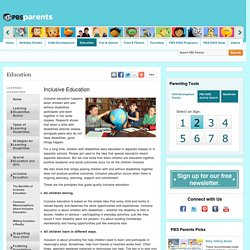
Research shows that when a child with disabilities attends classes alongside peers who do not have disabilities, good things happen. For a long time, children with disabilities were educated in separate classes or in separate schools. People got used to the idea that special education meant separate education. But we now know that when children are educated together, positive academic and social outcomes occur for all the children involved.
We also know that simply placing children with and without disabilities together does not produce positive outcomes. These are the principles that guide quality inclusive education: The Benefits of Inclusive Education . Learning Disabilities . Education. Here are key findings about the benefits of inclusion for children and families: Families’ visions of a typical life for their children can come true.

All parents want their children to be accepted by their peers, have friends and lead “regular” lives. Inclusive settings can make this vision a reality for many children with disabilities. Children develop a positive understanding of themselves and others. When children attend classes that reflect the similarities and differences of people in the real world, they learn to appreciate diversity. Making Inclusion a Reality . Learning Disabilities . Education. What you can do to promote inclusion for your child: Encourage your child to participate in activities where she can meet children her same age with different abilities.
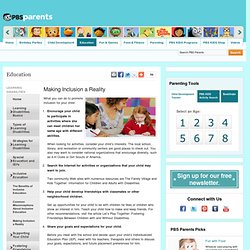
When looking for activities, consider your child’s interests. The local school, library, and recreation or community centers are good places to check out. You also may want to consider national organizations that encourage diversity, such as 4-H Clubs or Girl Scouts of America. Search the Internet for activities or organizations that your child may want to join. IDEA - Building The Legacy of IDEA 2004. (5) Least restrictive environment.-- (A) In general.
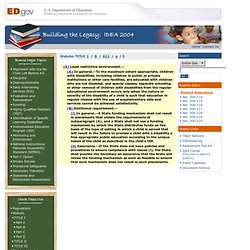
--To the maximum extent appropriate, children with disabilities, including children in public or private institutions or other care facilities, are educated with children who are not disabled, and special classes, separate schooling, or other removal of children with disabilities from the regular educational environment occurs only when the nature or severity of the disability of a child is such that education in regular classes with the use of supplementary aids and services cannot be achieved satisfactorily.
(B) Additional requirement. IDEA—the Individuals with Disabilities Education Act. Benefits of Inclusive Education. Inclusion: The Pros and Cons. The purpose of this paper was to review, analyze, and critique the pros and cons, the advantages and disadvantages, of inclusion.
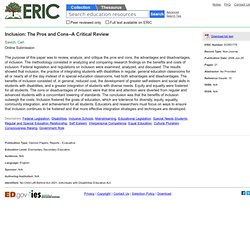
The methodology consisted in analyzing and comparing research findings on the benefits and costs of inclusion. Federal legislation and regulations on inclusion were examined, analyzed, and discussed. The results showed that inclusion, the practice of integrating students with disabilities in regular, general education classrooms for all or nearly all of the day instead of in special education classrooms, had both advantages and disadvantages. The benefits of inclusion consisted of, in general, reduced cost, the development of greater self-esteem and social skills in students with disabilities, and a greater integration of students with diverse needs. Highly gifted children in full inclusion classrooms.
Kearney, K.
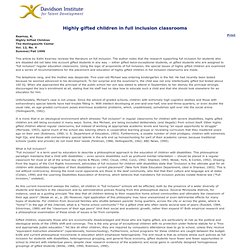
Highly Gifted Children The Hollingworth Center Vol. 12, No. 4 Summer/Fall 1996 This article by Kathi Kearney reviews the literature on full inclusion. The author notes that the research supporting full inclusion for students who are disabled did not take into account gifted students in any way -- either gifted twice-exceptional students, or gifted students who are assigned to "full inclusion" regular education classrooms. Using the logic of proponents of full inclusion, the special issues of highly gifted children are examined and a series of recommendations for the placement and education of highly gifted children in full inclusion classrooms are made.
The telephone rang, and the mother was desperate. Unfortunately, Michael's case is not unique. Five Barriers Associated with Inclusion Education. Barriers Associated with Inclusion in Education Expense Funding is a major constraint to the practice of inclusion.
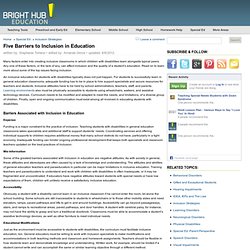
Teaching students with disabilities in general education classrooms takes specialists and additional staff to support students’ needs. Coordinating services and offering individual supports to children requires additional money that many school districts do not have, particularly in a tight economy. Inadequate funding can hinder ongoing professional development that keeps both specialists and classroom teachers updated on the best practices of inclusion. Mis-Information. NAEP - Inclusion of Special-Needs Students. Current Current Policy It is important for NAEP to assess as many students selected to participate as possible.
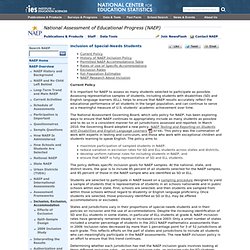
Assessing representative samples of students, including students with disabilities (SD) and English language learners (ELL), helps to ensure that NAEP results accurately reflect the educational performance of all students in the target population, and can continue to serve as a meaningful measure of U.S. students’ academic achievement over time. The National Assessment Governing Board, which sets policy for NAEP, has been exploring ways to ensure that NAEP continues to appropriately include as many students as possible and to do so in a consistent manner for all jurisdictions assessed and reported.
In March 2010, the Governing Board adopted a new policy, NAEP Testing and Reporting on Students with Disabilities and English Language Learners (67 KB). The policy defines specific inclusion goals for NAEP samples. Top history.